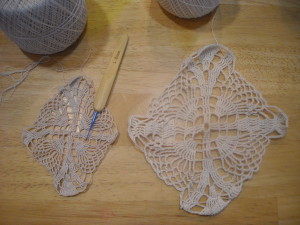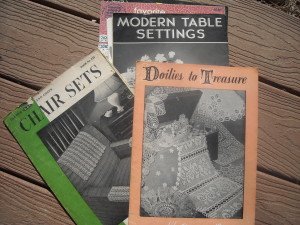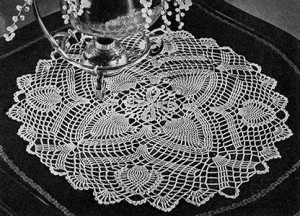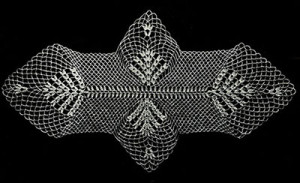Tips from the Doily Nerd: Getting that Vintage Look
By Molly Ferriter – 12 Comments| In my doily nerd opinion, the only thing better than a doily is a vintage doily. But how can crocheters today achieve the look of a vintage doily? In this post we will be traveling back in time to the days when every household had doilies on display and every armchair had antimacassars. (What is an antimacassar? Read on…) I will be discussing the thread and patterns needed to achieve the vintage look. |
 
First, let’s talk crochet thread. The majority of doily makers today use size 10 crochet thread. However, in the first half of the 20th century, crocheters typically made doilies out of much smaller thread. A few months ago I made the jump from size 10 crochet thread to size 30. It took a little bit to get used to, but the look is remarkable. The smaller size thread immediately gave my doily a vintage look. It created a more intricate, lacy look that is unmistakably vintage. With my first piece, I fell in love with size 30 thread. The delicate, elegant look of smaller thread is stunning. Crocheters from the first half of the 20th century frequently used even smaller thread than size 30.

Size 30 thread vs Size 10 thread
Secondly, we need a good vintage pattern. There are many great sources for vintage crochet patterns. I’ll just share a couple of them today. Do a google search and you’ll find even more!
The first site is freevintagecrochet.com. I use this webpage all the time as it is a wonderful source for all kinds of vintage crochet patterns and has a huge collection of vintage and antique doily patterns. Sign up for the newsletter and you can receive updates, showing the vintage pattern books that have been added to the site every month. You can pay for a collection of newly digitized vintage pattern books or you can download patterns individually for free. I love this site and am amazed at the sheer number of books that they have made into ebooks that are now available to everyone. Look under pattern categories for a categorized list of vintage patterns. Look under “restored pattern books” for a HUGE list of actual vintage and antique pattern books that have been placed on the site. This site is a treasure! One other great place to find vintage patterns is Ebay. I have purchased several original pattern books on Ebay for very low cost. The multitude of vintage pattern books available is astounding! The picture on the right is just a trickle of the vintage books I have purchased through Ebay at very cheap prices.
One other great place to find vintage patterns is Ebay. I have purchased several original pattern books on Ebay for very low cost. The multitude of vintage pattern books available is astounding! The picture on the right is just a trickle of the vintage books I have purchased through Ebay at very cheap prices.
The third site that I love is actually a Yahoo group. Celt’s Vintage Crochet takes crochet patterns that are in public domain and makes them available to its group members. There are some wonderful old patterns here and the group is a lovely collection of people dedicated to preserving crochet history. Love it!
Let me know in the comments section about your experiences with vintage doily projects. Have you ever crocheted using size 30 thread or used a vintage pattern? Should I tell you what an antimacassar is? No, I think I’ll leave it for the comments section. Wink, wink!




Love love love doilies. Grew up with them and watching my Italian Aunties starching & stretching them on pin boards . Remember the ones that were 3d with roses that stood up from the doily. Such lovely art! The thread was oh so tiny! I have been learning to do this work but where can I find steel hooks that have an ergonomic grip? I find the larger hooks B to K but not the steels and your hand gets so cramped trying to grasp that thin little hook shaft for any length of time.
I got the wooden-handled crochet hooks from ebay. They were extremely cheap. A few dollars for a set that goes from 2.5 mm to 1.0 mm but they are available in smaller sizes as well- I bought a set that went well below 1.0mm as well. I am with you- I don’t do any crocheting with a hook that doesn’t have the wooden handle.
Check at Joann’s, Michael’s or Meijer’s in the crochet hook area for a product by a company called Kahoots, it’s an assortment size package of spongy type hook grippers. I love them and with getting about 5pkgs I had enough of the different sizes for ALL my hooks!
I LOVE freevintagecrochet.com. I do- in fact I have the page open almost continuously and refresh the “Recent Posts” twice a day for any new patterns! I “Liked” The Purple Kitty FB page- now, that out of the way- and NO offense at all to the lady who does the pages, but some of the patterns…. well, ahem. These are written a long time ago, and the instructions are nothing as detailed and “user friendly” as one’s made today (back then they assumed you already knew how to crochet and well!) I made a beret from a pattern on the site, exactly as written, ugh… it was made up of panels that you sc all together, many panels mean many cut ends, right? It was murder trying to weave in (hide, that is) all those yarn ends, then to top it off- the beret was WAY small, not even fitting a child’s head (yes my gauge was absolutely spot on, even made it 1/3 ” larger than!) some of the patterns show one photo- but if you make it? Yeah good LUCK with that. This is not a cut on her page, but actually a commentary on old patterns in general. Not all of them are “oh how CUTE!” you know. PS- when was the word “vintage” meaning changed to mean “old”? Vintage, the definition refers to WINE= “vin’ as in, the wine is LaFitte Rothschild 1963 vintage” or, “it is of 1950’s vintage” vintage, must always be used WITH the year or circa year – not alone. One does not say “it’s vintage” one says “it’s vintage 1950”. It somehow changed its definition and usage recently as in within the past ten years.
You have me looking up “vintage” and its etymology! I love vintage patterns. It’s true, though, that older patterns are written differently than we are used to and some can be a bit difficult to follow. I love the sites that update the patterns like the celtsvintagecrochet group. Here’s what I found on “Online Etymology Dictionary” :
early 15c., “harvest of grapes, yield of wine from a vineyard,” from Anglo-French vintage (mid-14c.), from Old French vendage, vendenge “vine-harvest, yield from a vineyard,” from Latin vindemia “a gathering of grapes, yield of grapes,” from comb. form of vinum “wine” (see wine (n.)) + stem of demere “take off” (from de- “from, away from” + emere “to take;” see exempt). Sense shifted to “age or year of a particular wine” (1746), then to a general adjectival sense of “being of an earlier time” (1883). Used of cars since 1928.
Interesting- I love etymology!
Hello from a fellow Celty member. 🙂 I love the smaller thread, and am amazed every time I switch back to #10…it feels like crocheting with rope! Another thing to remember, thread crochet is generally worked tighter than with yarn. Many of us struggle to relax our tension on our yarn, but thread crochet benefits from tighter stitches.
Hi! I love that group! So many fabulous patterns- not enough time! I was amazed at how different the size 30 and 10 really are. I agree with you- with loose tension, doilies would not look very good. I’m a tight crocheter and I think it benefits my doilies. Nice to see a fellow Celty member on Crochetspot!
Being a literary sort of person, I know that an antimacassar goes over the back of a chair or over the arm of a chair. PS I also love the hooks with wooden handles.
Yay! First one to answer! And you are right!
I have visited your website looking for mandela patterns and you do lovely work. My grandmother left enough antimacassers for the whole family. I never got to meet her but my grandfather washed and ironed them and kept them on 2 sets of furniture. They are made in the pineapple pattern. I haven’t looked at them for years. I’m 65 so you can guess how old they are.
What a wonderful family treasure. Thanks for sharing that with us! I, personally, love making anything in the pineapple pattern. So beautiful.
Try the UNIVERSAL ERGONOMIC CHROCHET HOOK HANDLE.
I purchased it from Walmart for a couple of dollars. It has 8 adapters to secure the hook* inside of a comfortable oval holder. * accommodates sizes from 2.25mm – 6.5mm.